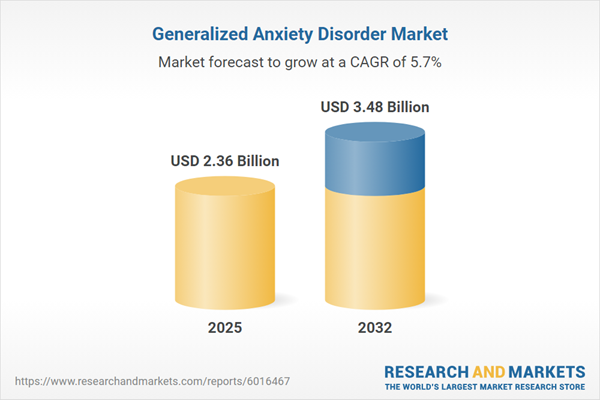Speak directly to the analyst to clarify any post sales queries you may have.
Senior decision-makers in the generalized anxiety disorder market must navigate evolving expectations, regulatory pressure, and an increasing demand for integrated, patient-focused care. To compete effectively, organizations are pursuing innovation, digital transformation, and flexible operational models that respond to a dynamic sector landscape.
Market Snapshot: Growth and Outlook for the Generalized Anxiety Disorder Market
The generalized anxiety disorder market demonstrates consistent expansion, reflected by increased stakeholder investment and rising industry awareness. Leadership across the sector is adopting a mix of established pharmaceutical options and next-generation digital interventions, such as telehealth therapy and virtual care platforms. Regulatory adjustments and global shifts in demand are driving change, while new models for care delivery are improving operational efficiencies and market differentiation. Ongoing demographic and societal changes further position the market for opportunity and responsive innovation across product and service lines.
Scope & Segmentation of the Generalized Anxiety Disorder Market
This report delivers detailed segmentation to assist organizations in resource alignment and targeted growth across critical areas of the generalized anxiety disorder market:
- Treatment Types: Digital therapeutics—including cognitive behavioral therapy applications, mindfulness and online care platforms, virtual reality tools, teletherapy solutions—over-the-counter supplements, prescription medications such as benzodiazepines, buspirone, SNRIs, SSRIs, and comprehensive therapy services like group, psychodynamic, supportive counseling, and cognitive behavioral models.
- Distribution Channels: Hospital pharmacies, digital and e-commerce pharmacies that feature telepharmacy solutions, and retail outlets serving a variety of procurement preferences.
- Patient Age Groups: Adolescents, adults, children, and elderly segments, each requiring tailored approaches and specific care models.
- Gender: Female and male patient groups, supporting targeted market strategies and differentiated care pathways.
- Symptom Severity: Mild, moderate, and severe cases to ensure adaptability in treatment escalation and care planning.
- Regions: Americas—including North and Latin America, Europe, Middle East & Africa, and Asia-Pacific. The report covers more than 30 countries, highlighting cultural and regulatory variation.
- Key Companies: Pfizer Inc., Eli Lilly and Company, GlaxoSmithKline plc, AbbVie Inc., H. Lundbeck A/S, Roche Holding AG, Teva Pharmaceuticals Industries Ltd., Viatris Inc., Sandoz International GmbH, Dr. Reddy’s Laboratories Ltd. These entities contribute to integration and innovation throughout the sector’s value chain.
Key Takeaways for Senior Decision-Makers
- Adoption of digital health technologies, including therapy apps and online wellness tools, is supporting transformed care delivery and enhanced patient engagement.
- Changes in global regulatory policy have streamlined market access for digital and digital-device-based interventions, promoting quicker transitions from concept to clinical use.
- Precision medicine and genetic profiling advancements enable organizations to better match pharmaceutical regimens to individual patient needs.
- Integrated care models, which utilize advanced therapeutics and real-world data sources, are improving adherence, timely decision-making, and care outcomes.
- Understanding differences in infrastructure and regulations across regions supports market localization, better value creation, and targeted service delivery.
- Increasing interest in supplement-based options and regionally adapted therapy methods allows care providers to respond proactively to evolving regulatory frameworks and patient preferences.
Tariff Impact on Innovation in Anxiety Disorder Treatment
Recent United States tariff policies, effective in 2025, influence both pharmaceutical and digital supply chains, creating new challenges for procurement and logistics. Healthcare organizations are countering these challenges by reviewing supplier networks, investing in domestic production, and establishing new regional partnerships. These steps support exploration of alternative therapeutic pathways, strengthen supply chain resilience, and encourage domestic innovation in the generalized anxiety disorder market.
Methodology & Data Sources Supporting Market Insights
This report’s insights are generated from a robust mixed-methods approach. Data includes primary research through interviews with healthcare executives, patient advocates, and industry leaders, reinforced by a review of clinical literature, regulatory filings, and health databases. Cross-verification and scenario analysis enhance confidence in market forecasting and compliance trends.
Why This Report Matters for Strategic Leadership in the Generalized Anxiety Disorder Market
- Supports critical investment, product development, and operational decisions with up-to-date intelligence on new technologies, treatment modalities, and varied market dynamics.
- Guides senior leaders through complex reimbursement structures, partnership opportunities, and adapting supply chains to meet region-specific challenges.
Conclusion
By clarifying shifting market drivers and operational complexities, this report empowers executives to make informed strategic choices, adapt with confidence, and optimize patient outcomes in a rapidly changing environment.
Additional Product Information:
- Purchase of this report includes 1 year online access with quarterly updates.
- This report can be updated on request. Please contact our Customer Experience team using the Ask a Question widget on our website.
Table of Contents
3. Executive Summary
4. Market Overview
7. Cumulative Impact of Artificial Intelligence 2025
Companies Mentioned
The companies profiled in this Generalized Anxiety Disorder market report include:- Pfizer Inc.
- Eli Lilly and Company
- GlaxoSmithKline plc
- AbbVie Inc.
- H. Lundbeck A/S
- Roche Holding AG
- Teva Pharmaceuticals Industries Ltd.
- Viatris Inc.
- Sandoz International GmbH
- Dr. Reddy’s Laboratories Ltd.
Table Information
| Report Attribute | Details |
|---|---|
| No. of Pages | 183 |
| Published | October 2025 |
| Forecast Period | 2025 - 2032 |
| Estimated Market Value ( USD | $ 2.36 Billion |
| Forecasted Market Value ( USD | $ 3.48 Billion |
| Compound Annual Growth Rate | 5.7% |
| Regions Covered | Global |
| No. of Companies Mentioned | 11 |









